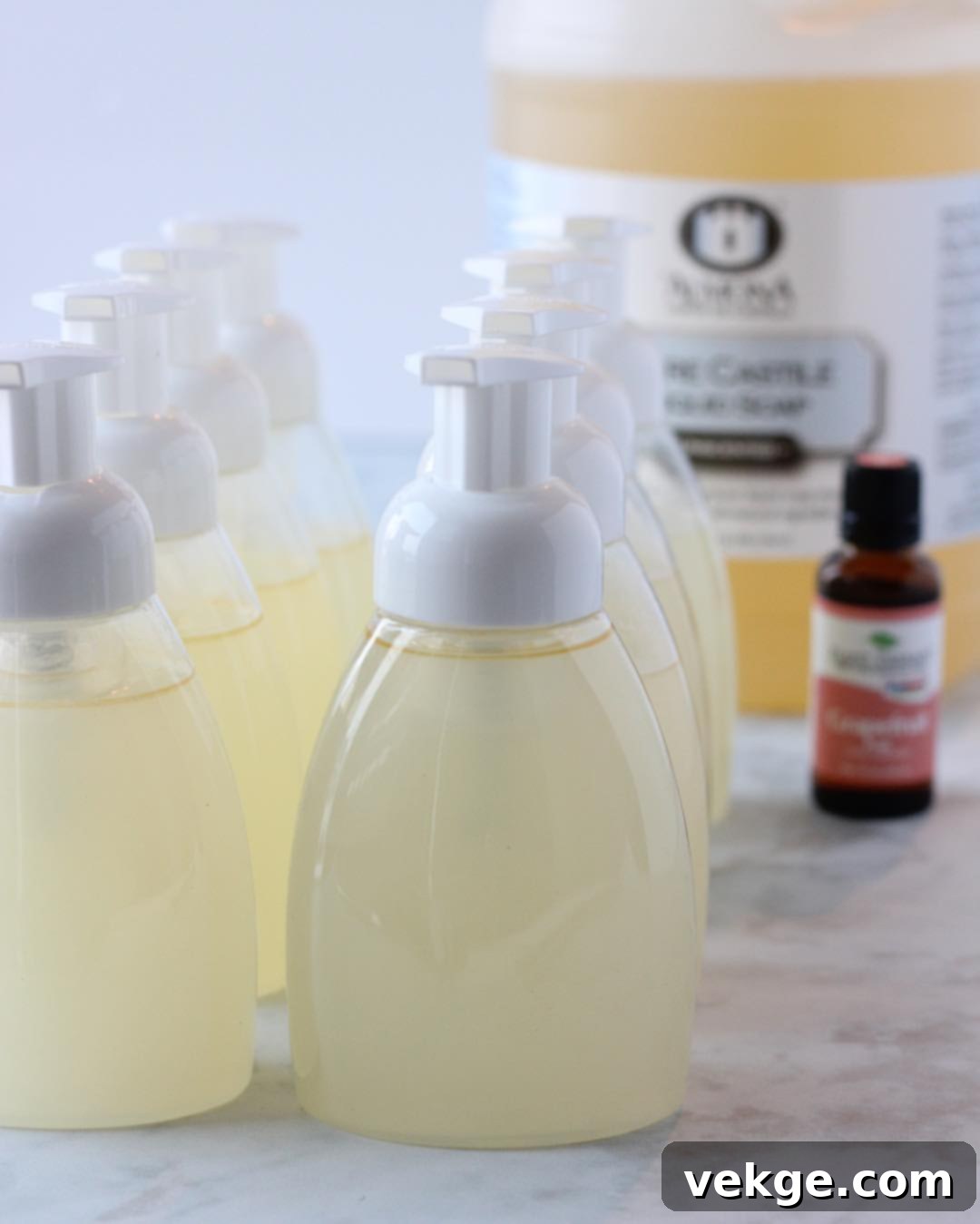DIY Non-Toxic Hand Soap: An Easy & Affordable Guide to Healthier Living
Embracing a healthier, non-toxic lifestyle can often feel overwhelming, but discovering simple swaps can make a huge difference. One of my favorite sources for practical, clean living inspiration is @just.ingredients on Instagram. Her approach to making healthier eating and living more accessible is truly remarkable and empowering. Recently, she shed light on a common household item often overlooked: traditional hand soaps. Many commercial hand soaps are surprisingly loaded with harsh chemicals, artificial fragrances, and parabens – ingredients our bodies readily absorb through the skin. This revelation prompted her to share her incredibly simple and cost-effective method for creating homemade, clean-ingredient hand soap. I was immediately inspired to try it myself, and I couldn’t be happier with the results!
The journey to a more natural home doesn’t have to break the bank or involve complex processes. This DIY hand soap recipe is a testament to that. Not only does it allow you to eliminate questionable chemicals from your daily routine, but it also offers significant long-term savings compared to purchasing “healthy” or “natural” soaps from stores, which often come with a premium price tag. Let’s delve into how you can easily make this beneficial change in your home.
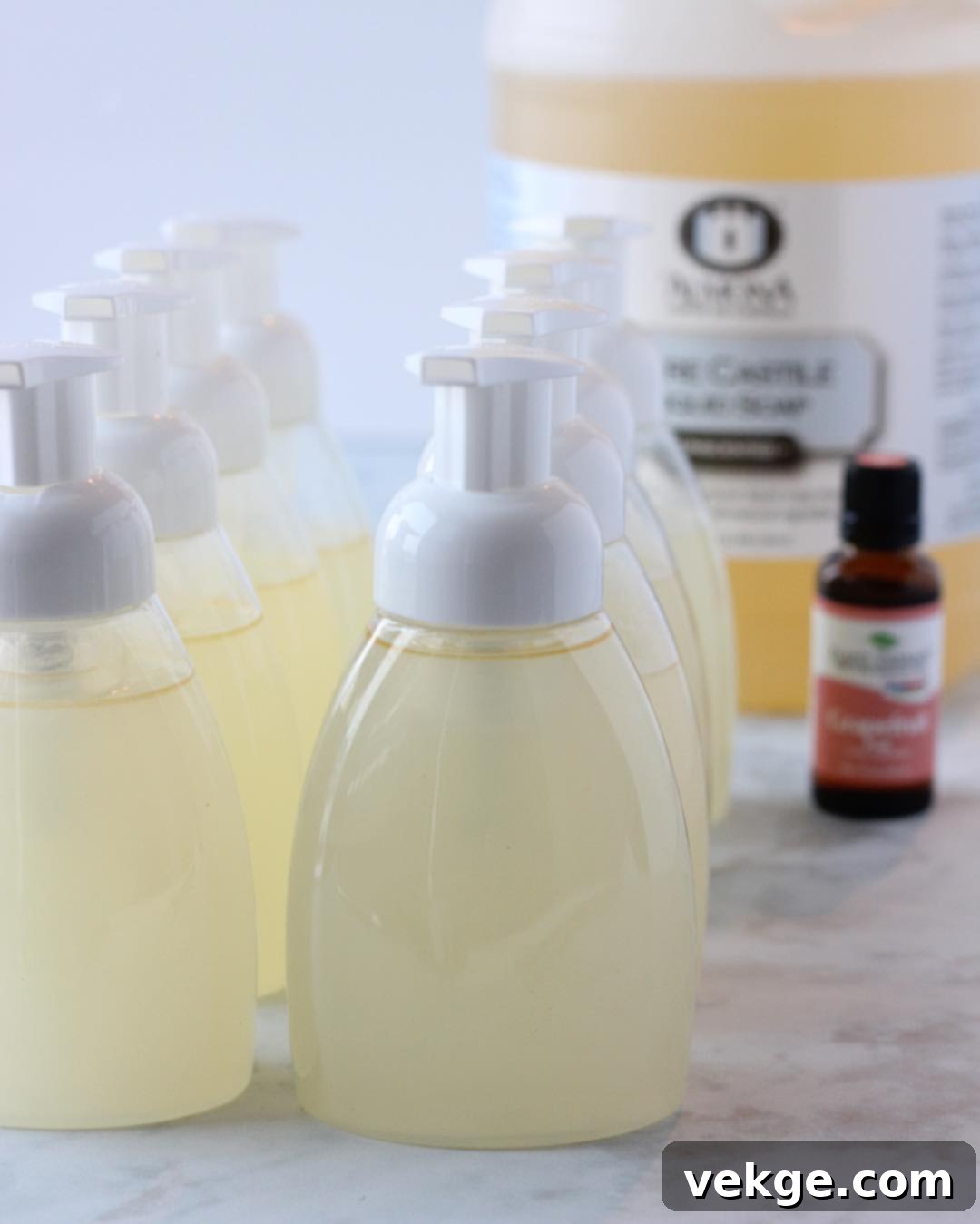
While the initial outlay for supplies like reusable soap dispensers might seem a bit higher, the economic benefits quickly become apparent. A single gallon of concentrated Castile soap can yield enough solution to fill approximately 32 standard hand soap bottles! Similarly, a quality bottle of essential oil will likely last for 64 or more batches, depending on how many drops you use per bottle. This means the cost per bottle of your homemade, non-toxic soap can be as low as $1.50 or even less! For me, that significant saving, coupled with the peace of mind knowing exactly what ingredients are touching my family’s skin multiple times a day, makes this DIY project absolutely worthwhile. It’s an investment in both your health and your wallet.
Why Choose Homemade Non-Toxic Hand Soap?
The decision to switch to homemade hand soap goes beyond just saving money; it’s primarily about health and well-being. Many conventional soaps contain a cocktail of ingredients that can be detrimental to our skin and overall health. Understanding these concerns highlights the profound benefits of making your own.
Health and Safety Benefits
- Avoid Harsh Chemicals: Traditional soaps often contain ingredients like sodium lauryl sulfate (SLS), phthalates, formaldehyde-releasing preservatives, and triclosan. These can irritate the skin, disrupt endocrine function, and even contribute to antibiotic resistance. By making your own soap, you eliminate these questionable additives.
- Paraben-Free: Parabens (e.g., methylparaben, propylparaben) are commonly used as preservatives in cosmetics and personal care products. They are known endocrine disruptors and have been linked to various health concerns. Homemade soap allows you to easily avoid them.
- Gentle on Skin: Castile soap, a key ingredient in this recipe, is incredibly mild and nourishing. It cleanses effectively without stripping the skin of its natural oils, making it ideal for sensitive skin and frequent hand washing.
- Reduced Allergen Exposure: Artificial fragrances are a major trigger for allergies and skin sensitivities. Using pure essential oils for scent allows you to choose natural, hypoallergenic options, or even leave your soap unscented.
Cost-Effectiveness
As mentioned, the long-term savings are substantial. While the initial purchase of a large bottle of Castile soap and essential oils might seem like an upfront cost, these concentrated ingredients last for a very long time. When you break down the cost per refill, it becomes clear that homemade soap is significantly more economical than even generic store-bought options, let alone expensive “natural” brands.
Environmental Impact
By refilling reusable soap dispensers, you significantly reduce plastic waste. This simple act contributes to a more sustainable lifestyle and helps minimize your ecological footprint. A single gallon of Castile soap can prevent dozens of plastic pump bottles from ending up in landfills.
Customization and Aromatherapy
One of the most enjoyable aspects of making your own soap is the freedom to customize the scent. Essential oils offer not only delightful aromas but also therapeutic benefits:
- Grapefruit: Uplifting and refreshing.
- Lavender: Calming and soothing, excellent for relaxation.
- Tea Tree: Known for its purifying properties.
- Lemon: Invigorating and naturally cleansing.
- Peppermint: Stimulating and refreshing.
- Eucalyptus: Invigorating and can help clear the senses.
You can blend different oils to create unique scent profiles that match your mood or the season.
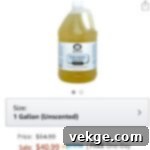
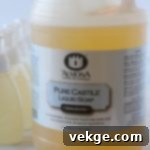
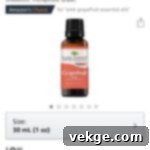


Previous
Next
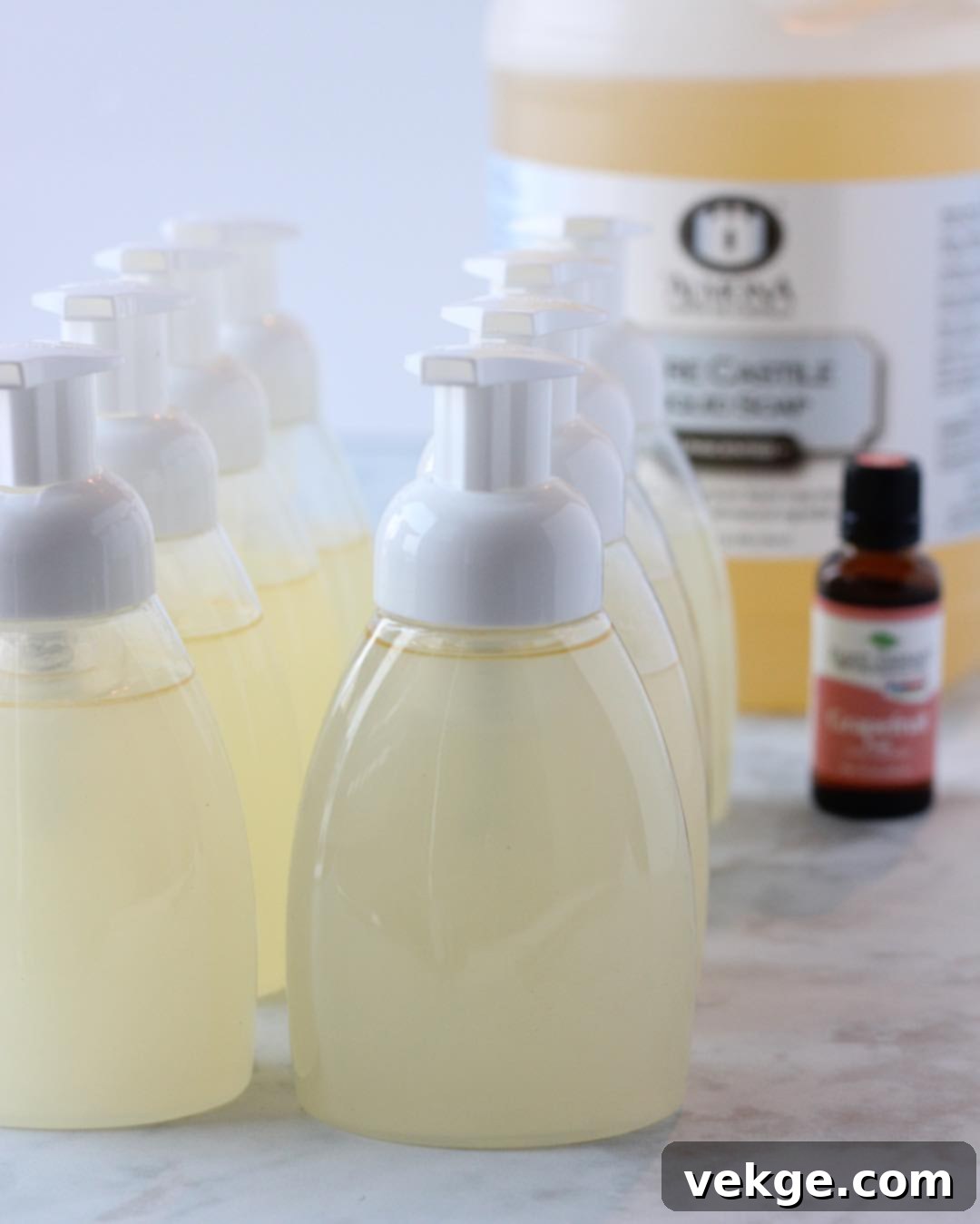
Key Ingredients for Your Homemade Hand Soap
The beauty of this recipe lies in its simplicity and the high-quality, natural ingredients it utilizes. Each component plays a vital role in creating a soap that is effective, gentle, and safe.
Liquid Castile Soap
This is the cornerstone of your homemade hand soap. Castile soap is an olive oil-based soap that originates from the Castile region of Spain. It is renowned for being natural, non-toxic, biodegradable, and incredibly versatile. It comes in both bar and liquid forms, but for hand soap, the liquid variety is essential. When diluted, it produces a gentle lather that cleanses without harsh chemicals. You can find various brands on Amazon or at health food stores. Look for unscented versions if you plan to add your own essential oils for fragrance.
Essential Oil of Choice
Essential oils are highly concentrated plant extracts that capture the plant’s scent and beneficial properties. They are used here not only for fragrance but also for their potential therapeutic benefits. As mentioned, I particularly love grapefruit essential oil for its refreshing and uplifting aroma, and the Plant Therapy brand is a personal favorite for its quality and purity. When selecting essential oils, ensure they are 100% pure and unadulterated to guarantee safety and efficacy. Always research the specific properties and safety guidelines for any essential oil you choose, especially if you have sensitivities or are using them around children or pets.
Liquid Soap Pump Dispensers
Choosing the right dispenser is important for both aesthetics and functionality. Opt for BPA-free plastic or glass dispensers. Glass offers a more elegant look and is inert, meaning it won’t leach chemicals into your soap. BPA-free plastic is a durable and safer alternative to conventional plastics. Consider dispensers with sturdy pump mechanisms that can withstand repeated use and refilling. These are a one-time purchase that will serve you well for years.
Distilled Water
While tap water might seem convenient, distilled water is highly recommended. Tap water contains minerals, chlorine, and sometimes other impurities that can affect the stability and longevity of your homemade soap. Minerals can lead to residue buildup, and chlorine can potentially interact with essential oils. Distilled water is purified, ensuring a cleaner, more stable, and longer-lasting product. It helps prevent bacterial growth that can occur over time in non-purified water, extending the shelf life of your soap.
Homemade Hand Soap Recipe

Homemade Hand Soap: Clean, Natural, & Refreshing
Print
Pin
Rate
Ingredients
- Liquid Castile Soap (any reputable brand will do; easily found on Amazon or at local health stores)
- Essential oil of choice for scent and therapeutic benefits (e.g., grapefruit for uplifting, lavender for calming. I highly recommend the Plant Therapy brand for quality.)
- Liquid soap pump dispensers (ensure they are BPA-free for health and durability. Glass or high-quality plastic are great options.)
- Distilled water (crucial for stability and purity, avoiding minerals and impurities found in tap water.)
Instructions for Mixing Your Hand Soap
- Prepare Your Dispensers: Begin by adding approximately 1/3 of liquid Castile soap to each clean, empty soap dispenser. This ratio ensures a gentle yet effective cleaning solution.
- Dilute with Distilled Water: Carefully fill the remainder of the dispenser to the top with DISTILLED water. It is crucial to add the water slowly to avoid excessive foaming. Leave a small amount of space at the top for the essential oils and to prevent overflow when inserting the pump.
- Add Essential Oils for Scent and Benefits: Now, add 5 or more drops of your chosen essential oil to each dispenser. The exact number of drops can be adjusted based on your personal preference for scent strength and the specific essential oil’s potency. Gently replace the pump top and give the bottle a light shake to combine all ingredients thoroughly.
- Enjoy and Refill: Your homemade, non-toxic hand soap is now ready to use! Simply refill your dispensers when necessary, following these easy steps each time.
Tips for Best Results and Customization
Making your own hand soap is incredibly straightforward, but a few additional tips can enhance your experience and the effectiveness of your product.
Adjusting the Ratio
The 1/3 soap to 2/3 water ratio is a great starting point for a gentle, all-purpose hand soap. However, you can experiment to find what works best for you. If you prefer a thicker lather or feel your hands need more cleansing power, you can slightly increase the amount of Castile soap. If you find it too concentrated, add a bit more distilled water. Always make adjustments incrementally.
Scent Blending
Don’t be afraid to get creative with your essential oil blends! Some popular combinations include:
- Calming Blend: Lavender and Chamomile
- Invigorating Blend: Lemon and Peppermint
- Purifying Blend: Tea Tree and Eucalyptus
- Sweet Citrus Blend: Grapefruit and Sweet Orange
Always perform a patch test if you’re trying a new essential oil or blend, especially if you have sensitive skin.
Troubleshooting Common Issues
- Soap Separation: It’s normal for the Castile soap and water to separate slightly over time, especially if not used frequently. A gentle shake of the bottle before each use will easily re-combine them.
- Clogged Pump: If your pump starts to clog, it might be due to hard water residue (if you didn’t use distilled water) or a very cold environment. Run the pump under warm water to clear it, or consider cleaning the pump mechanism with a small brush.
- Cloudiness: Using tap water can sometimes cause the soap to appear cloudy due to mineral content. This is another reason why distilled water is highly recommended for a clear, pristine product.
Extending Shelf Life (and What to Avoid)
Since this recipe uses water, there’s a natural concern about bacterial growth over time. Using distilled water significantly reduces this risk. While commercial soaps often contain preservatives, this natural recipe doesn’t. For best results, use your homemade soap within 3-6 months. If you notice any unusual smells or discoloration, it’s best to discard the batch and make a fresh one. Do not add fresh plant materials (like herbs or flowers) directly to the soap, as they can quickly introduce bacteria and mold.
Making it a Gift
Homemade hand soap makes a thoughtful and practical gift. Purchase attractive glass or ceramic dispensers, create custom labels, and tie a ribbon around them. It’s a wonderful way to share the benefits of non-toxic living with friends and family.
Embrace a Cleaner, Healthier Lifestyle
Making your own non-toxic hand soap is just one small, yet impactful, step you can take towards a healthier and more sustainable home. It’s empowering to know exactly what ingredients you’re using on your skin, and the cost savings are an added bonus. This simple DIY project, inspired by the wisdom of @just.ingredients, proves that clean living doesn’t require drastic changes or expensive products. With minimal effort and a few key ingredients, you can transform your hand washing routine into a safe, refreshing, and eco-friendly practice. Give it a try – your hands, your health, and your wallet will thank you!
